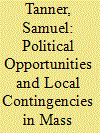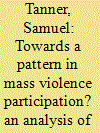|
|
|
Sort Order |
|
|
|
Items / Page
|
|
|
|
|
|
|
| Srl | Item |
| 1 |
ID:
140516


|
|
|
|
|
| Summary/Abstract |
Mobile technologies have brought about major changes in police equipment and police work. If a utopian narrative remains strongly linked to the adoption of new technologies, often formulated as ‘magic bullets’ to real occupational problems, there are important tensions between their ‘imagined’ outcomes and the (unexpected) effects that accompany their daily ‘practical’ use by police officers. This article offers an analysis of police officers’ perceptions and interactions with security devices. In so doing, it develops a conceptual typology of strategies for coping with new technology inspired by Le Bourhis and Lascoumes: challenging, neutralizing and diverting. To that purpose, we adopt an ethnographic approach that focuses on the discourses, practices and actions of police officers in relation to three security devices: the mobile digital terminal, the mobile phone and the body camera. Based on a case study of a North American municipal police department, the article addresses how these technological devices are perceived and experienced by police officers on the beat.
|
|
|
|
|
|
|
|
|
|
|
|
|
|
|
|
| 2 |
ID:
078972


|
|
|
|
|
| Publication |
2007.
|
| Summary/Abstract |
Participation in mass crime is often approached from a top-down perspective that centralizes the actions of the masses under the order of elites and leaders. While there is some evidence to support this approach, a more complete assessment of participation in mass crime must also consider the grassroots contingencies that unite the collective motivation and capacity that induce such actions. Such a bottoms-up approach is developed in this article with a particular focus on the personal experiences of former Serbian militiamen who took part in scenes of mass violence in Croatia and Bosnia-Herzegovina. Interviews with former militiamen illustrate how political opportunities, diverging nationalistic attitudes, proximity to growing violence in increasingly localized killing fields, incentives to participate in parallel criminal activities, and an influence within community networks that were submerged in mass crimes united to legitimize and facilitate their personal commitment to the events that took place in this region during the 1990s
|
|
|
|
|
|
|
|
|
|
|
|
|
|
|
|
| 3 |
ID:
107043


|
|
|
|
|
| Publication |
2011.
|
| Summary/Abstract |
In this article, I focus on the logic whereby a group of eight Hutu became involved in mass violence during the 1994 Rwandan genocide. This process is considered as a sequence of meaningful events that progressively shaped the actors' frame of analysis. As such, each sequence brings a new qualitative reality which, in turn, constitutes the platform upon which the involvement in, and the perpetration of, mass violence become acceptable and legitimate in the eyes of the perpetrators. Based on both Howard S. Becker's notion of career and Roger Petersen's analysis of resistance and rebellion, I disaggregate the entire process of participation in mass violence into a sequence of six mechanisms, generating two main phases. The first one, mobilisation, refers to the movement from a neutral state to a mobilised state. The second phase, collective action, covers the drift from mobilisation to action, namely, killings.
|
|
|
|
|
|
|
|
|
|
|
|
|
|
|
|
|
|
|
|
|